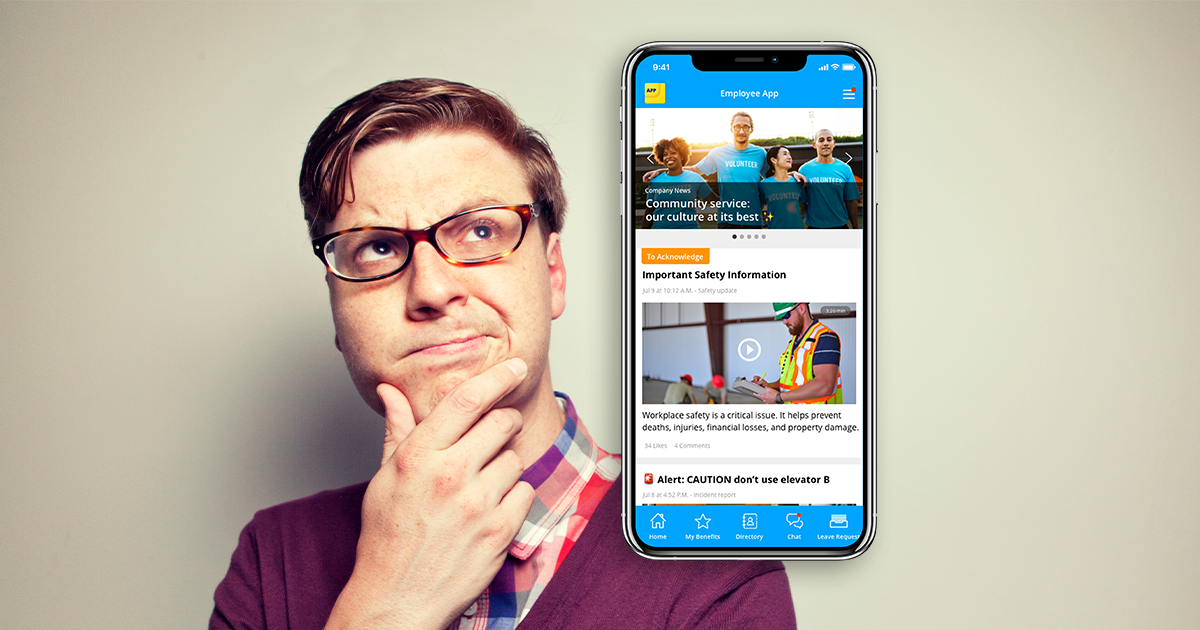It is an undisputed fact that today's employers need to engage their workforce in order to run a successful business. That's why many organizations are turning to employee engagement apps for the proven benefits they bring when it comes to interacting directly with their employees.
Companies with engaged employees outperform those without by 202%; customer retention rates are 18% higher when employees are highly engaged; and organizations that have more than 50% employee engagement retain more than 80% of their customers. Engagement is a key to every company's success.
Still, 88% of employees aren't passionate about their work; 58% of employees wouldn't recommend their workplace to their friends; and employee disengagement costs the US economy more than $500 billion per year.
Low employee engagement equals lower customer service and profits. It results in employees taking more sick days and it increases turnover rates. In comparison, high engagement boosts productivity, compells employees to stay in their current jobs, and helps to retain customers.
With work constantly changing and the gig-economy taking over, engagement must go mobile
Not only does mobile flip the top-down directives that dominate business communication, but it also enhances the employee experience. And it’s high time for companies to start thinking about employee experience in the same way they look at customer experience.
Millennials already expect mobile communication. They're true technology natives and they want information to be immediate, interactive, and accessible on-the-go. In addition, when considering where to work, today's employees value transparency as being one of a company's most important aspects.
While it's impossible to be the sole source of information, in order for your employees to stay engaged and for crisis management to work effectively, it is central that you are the first and most transparent source of information.
Furthermore, your workforce is already using their mobile devices: 72% of them, to be exact. This is why BYOD is such a big trend. Allowing your employees to use the devices that are embedded in their daily lives increases engagement and makes internal communication easier to distribute.
Mobile Means App
We use apps for shopping, banking, traveling, and for getting news and information. Why not for work?
Consider the advantages: Employee engagement apps are mobile and easily integrated into your employee's lives; they have high usability and are low in cost and easy to use; they increase engagement, enable social sharing, and are available on a channel that already exists in your employee's pockets.
Employee communication apps have extremely high reach and enable push notifications; they support your employer brand, can be implemented in as little as four weeks, facilitate communication in different languages, empower collaborations, give your employees a chat platform that isn't WhatsApp or Facebook, and open content creation to everyone.
Apps are able to function with your intranet or alongside it — and they can be configured with SharePoint; all workers can have access, security can be designed to meet specific needs, use cases can be adapted, and they are superior to traditional channels like newsletters or in-house magazines.
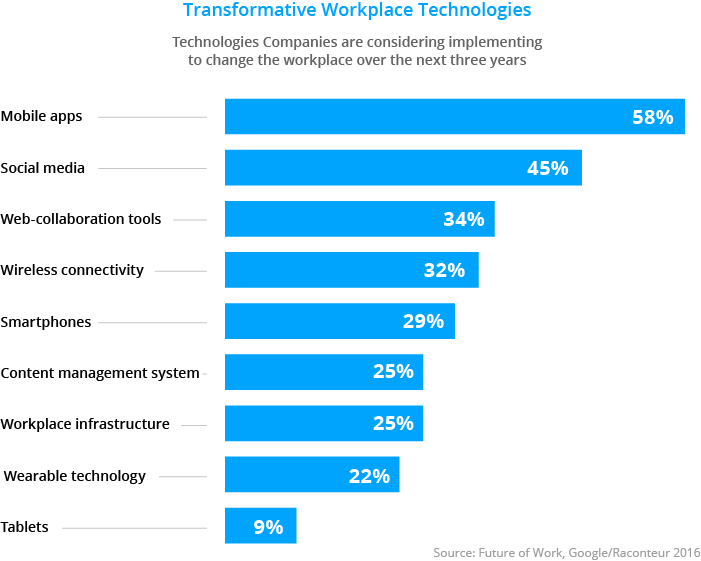
How to Get Started: 10 Steps to Your Own Employee Engagement App
1. Convince the C-Level
You know you should get rolling with mobile communications — but how do you convince your leadership? It's key to have a clear understanding of what your organization is trying to achieve — and why. This will help you to establish a clear “line of sight” between the benefits of an employee app and your team’s and organization’s goals.
In addition, remember to provide several options beyond just yes or no. You could, for example, ask to start a research phase or an employee app pilot at a limited number of locations or a leadership conference.
Also, be prepared for a second or third round of talks. If your leaders don’t immediately choose one of your recommendations, collect their open questions, negotiate a timeframe, and immediately set a follow-up meeting.
If you'd like further inspiration on how to sell an app to your boardroom, download our slide deck here.
2. Do We Make or Buy Our App?
Custom app projects are often widely underestimated, both in terms of time and cost.
A custom app project takes approximately eighteen months to develop and launch — and that's only if you already have a full IT team specialized in mobile applications. In comparison, the Staffbase app enables you to go from an initial idea to your own fully implemented branded app in as quickly as 15 days.
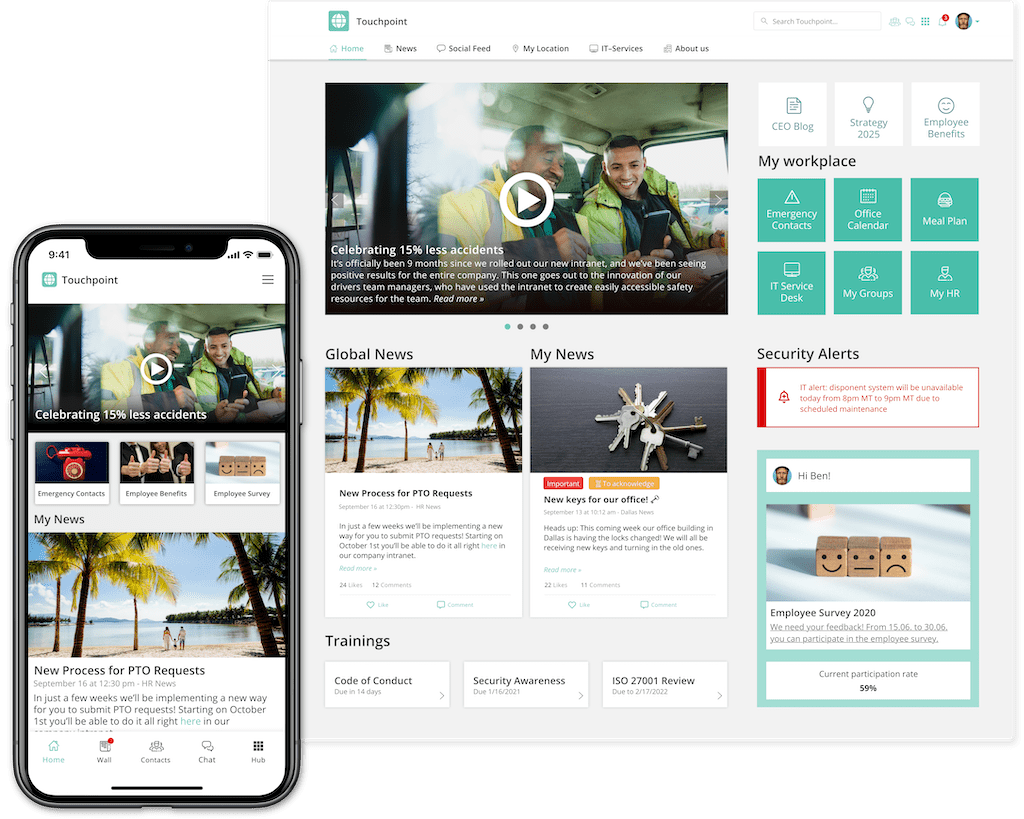
A SaaS solution will have already been verified by other companies, use cases have been tested, and value has been proven. In addition, the cost is significantly lower since the investment for platform development and maintenance is “shared” by all customers.
3. Is App Use Voluntary or Mandatory?
As a principle, internal communication should always be voluntary. If you try to force information on your employees, it defeats the whole purpose of trying to engage them. This voluntariness must be executed on two fronts: Facilitating BYOD and making the app download voluntary.
Already more than 50% of companies allow their employees to bring their own device and an additional 15% plan to do so in the near future.
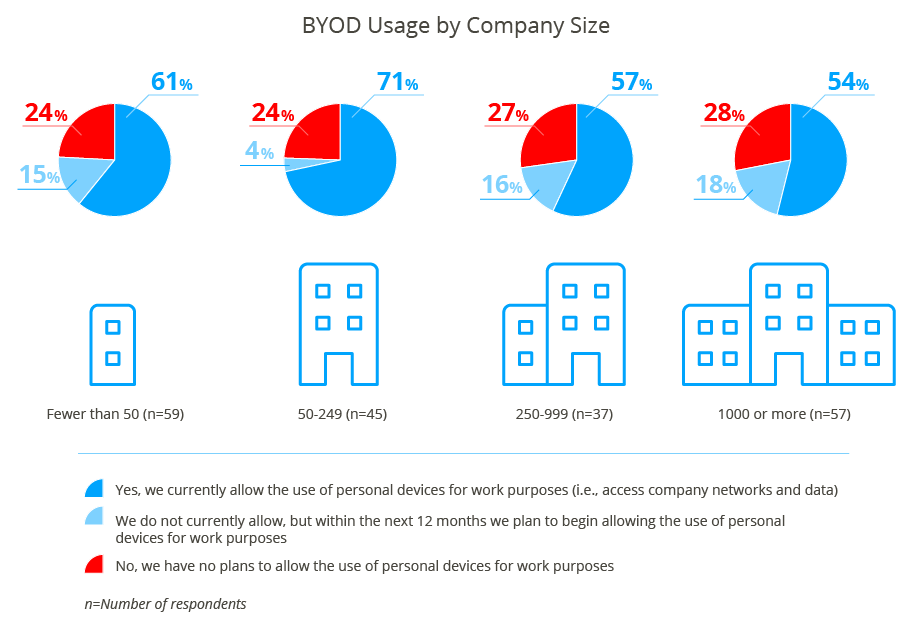
There will naturally be voices that speak out against using private phones for work-related matters. For these people, as well as for those who are less than motivated to download the app, it's important to create additional value, something which can be achieved with the right use cases.
4. Decide between Native App and Web App
Native apps are deployed through the public App Store, while a web app is basically a website accessed through a mobile browser on a smartphone. Native apps are a better employee engagement solution for several reasons, two of the most important being their App Store deployability and their ability to facilitate push notifications.
Being deployed over the public App Store enhances an employees' user experience because he or she will be familiar with the process and updates are applied automatically.
Not only do web apps lack a straightforward user experience, but they are also often difficult to install and have limited access, thus being suitable only for a limited number of users.
5. Establish Your First Use Cases
The main goal of your engagement app is to create additional value for your users. Which is why the first use cases you roll out are so important.
The following illustration highlights the use cases that create "value with a heart." In order to ensure high onboarding numbers, we recommend that you launch your app with at least one of these "heart cases." You can grow your app from there.
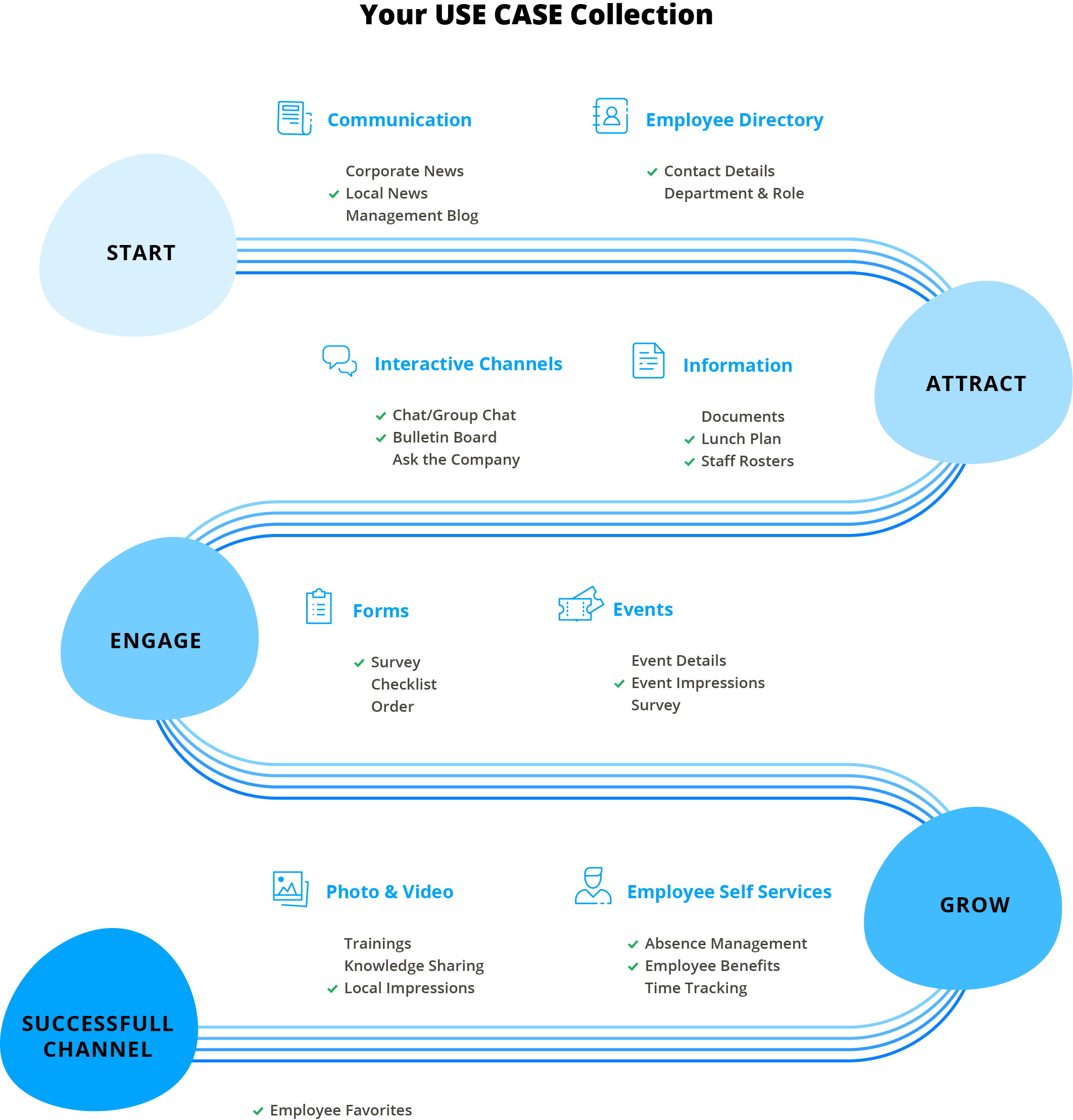
Learn more about the best use cases for engaging your employees.
6. What Kind of Content Goes in the App?
In addition to considering the framework, it’s also important to think about what you plan on doing inside the app. Mobile requires a new approach to content and functionality. When thinking about your app content, remember that it shouldn't be a dumping ground for old intranet or newsletter content.
Employee engagement apps provide the opportunity to reach your employees in completely different and more diverse ways. Waiting for the bus, between meetings, at home, or at lunch. The majority of your content should be short, easy to read on-the-go, relevant to your employees, and, ideally, created by your people. Longer pieces will still have a place, but they're only appropriate when they have long-term relevance.
Follow these useful guidelines to see if your content is APPropriate:
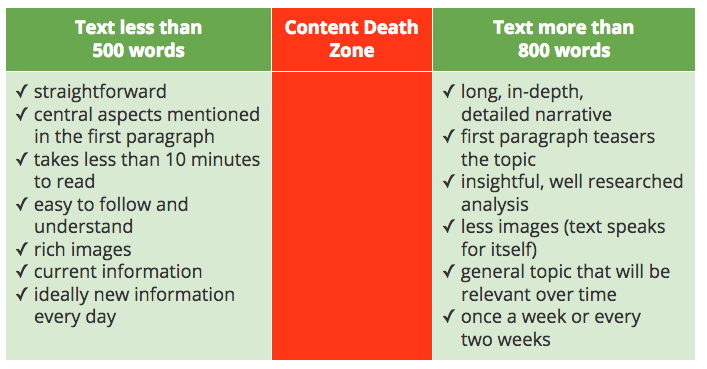
7. What Are the Security Guidelines?
Think about security inside the app as well as outside.
There are two central aspects inside the app. First, limit the information you put online. Every piece of content you create doesn't need to be part of your app. Consider the following content security guidelines:
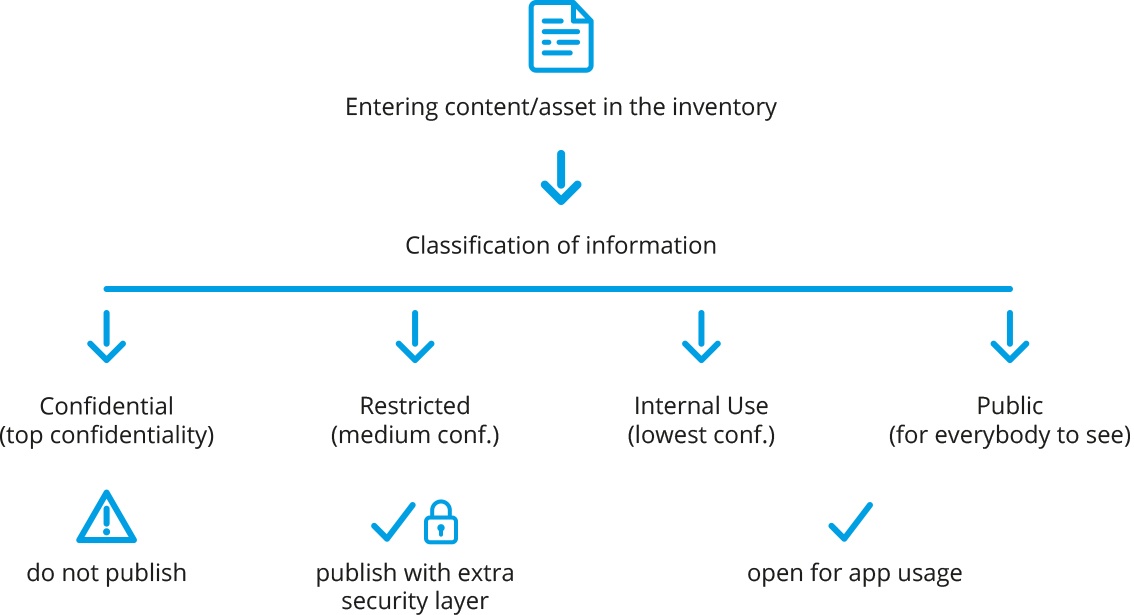
Second, consider the lifetime of your user’s sessions. It is of course easier if employees remain logged in, but you should consider the maximum lifetime of a user's sessions and adjust the security appropriately, based on your company's policies.
Outside, consider the login credentials as well as where the app is supposed to be hosted. Staffbase offers multiple onboarding techniques for different levels of security, and you're free to choose hosting options in both the US and Germany.
8. How Do We Onboard Employees to the App?
After your employees download the app they will have to log in to the protected area of your Staffbase employee app.
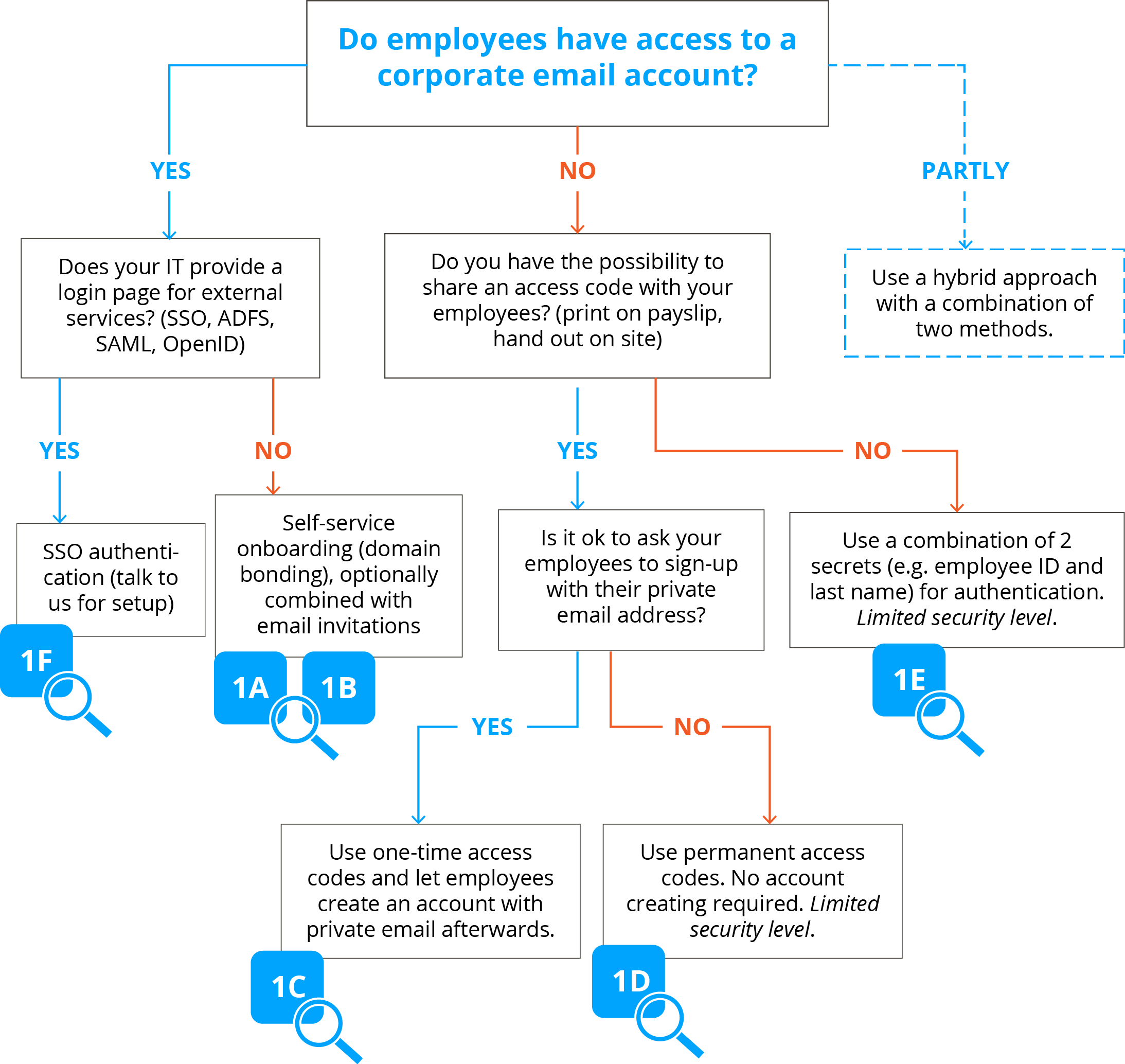
What you must now decide is which onboarding technique to choose.
9. How Will an App Align with Your Intranet?
An employee app can be viewed as a channel displaying the intranet or as an addition to the intranet. What you need to decide is how content will be shared or not shared between the two platforms. Having a direct connection between the two is often not an option due to security concerns.
The ideal solution is a CMS. This ready-to-go system lives between the app and your intranet and holds all information that isn't highly confidential or highly relevant to your employees. This way, content can be pushed to both the intranet and the app — while still remaining secure.
10. What's Our App Rollout Strategy?
When it comes to your launch, the question is whether to roll things out with a bang or to start with a soft launch. Experience has shown that a soft launch generally makes more sense.
A soft launch enables you to build your app from the ground up with the input of your employees. You avoid the danger of launching a much anticipated project that your users don’t like, and instead include them in the process of its creation.
In addition, use cases need to be developed, specified, and adapted. Your app is an evolving platform that can be modified with flexible plugins in order to handle all situations in the company. A soft launch supports this approach and enhances value growth.
Mobile internal communication is the future of the workplace, and employee engagement apps will enable employers to connect to their workforce in new and exciting ways.
Read more about employee communication apps:
- Employee Communication Apps: 10 Benefits of a Mobile Comms Platform
- Employee Apps: 8 Steps for Finding the Best
- Why Companies Choose Staffbase as their Employee Communications Platform
- Employee Engagement Apps: 10 Decisions to Make Before You Start
- Learn More about the Staffbase Internal Communications App
